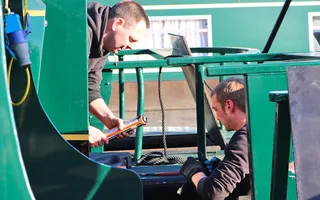Boat breakdowns are increasing the number of call-outs, but many faults are caused by a lack of maintenance.
Fuel issues and contamination
Diesel Bug and water contamination accounts for most fuel-related breakdowns. The bug is an enzyme that lives off water in diesel. In its mildest form it appears as black dust or soot, at its worse, its a black slime or jelly.
Once in the system it clogs the engine's fuel arteries and stops the engine working. Adding specialist fluid to the tank stops the bacteria from growing and kills anything that may be forming in the tank. For more severe cases (or when the fuel system is blocked) a Diesel Bug shock treatment is necessary.
Blocked filters and fuel contamination due to dirt and debris in the tank is easily rectified through regular checks and servicing. Marinas now offer fuel polishing services which clean fuel without having to treat or dispose of the contaminated fuel.
Keeping water out of your fuel tank through regular maintenance does help.
Electrical issues
Primarily due to a lack of attention to electrical connections where wires may be coming away or corroding. Before any journey, check and look for loose connections or disconnected wires and use a water-resistant spray or petroleum jelly to stop dame getting into electrical components such as isolators and block connectors.
Cooling systems and over-heating
An air-lock in the cooling system is simple to identify and resolve. Feel the top and bottom of the swim tank; if everything is working fine there should be a difference in temperature (hot at the top and cool at the bottom in most cases). If not, both top and bottom will be hot or cold.
To remedy this, locate and unscrew the bolt that sits on top of the swim tank; this will release the air locked in the system. Over-heating can be caused by many issues from a coolant hose rupturing (look for leaks), a water pump failing or a fan belt shredding (which drives the water pump) or the worst case, a head gasket failing.
Battery issues
Typically, due to misunderstandings around battery use, electrical capacity and charging – eg. using a leisure rather than a cranking battery or linking the domestic system to a starter system, could leave the boat without power when it's most needed.
Cranking and leisure batteries are designed differently; a cranking battery delivers a high output quickly and discharges/charges back to full capacity equally quickly. A leisure battery delivers a lower output continuously and if it's charged regularly, will maintain capacity. Generally, and assuming it's in a good condition, each battery in a battery bank needs two to three hours charging to get back to full performance once fully discharged.
If the wrong battery is used, the sudden surge of power needed to start the engine can quickly drain capacity on a leisure battery and whilst regular charging helps to regain these levels, using this type of battery will eventually lead to battery failure.
Many leisure batteries are modified starter batteries and while suitable for owners using boats sporadically, they can prove unreliable for more frequent users. For live aboard and frequent users it's better to invest in true leisure batteries.
Each battery cell has an impact on the whole battery bank, and one of the best ways to prevent battery deterioration is to regularly check and top up water levels in the cells (using de-ionised water). If one cell's water level drops below 50%, it will bring the overall bank capacity down to the same level, irrespective of how good the other batteries are. Never mix and match batteries - always replace the whole bank of old ones with new ones.
Similarly, battery terminals should not be forgotten - if they're tight and greased they'll deliver a good connection. It only needs one loose terminal to cause engine failure; usually the main earthing cable (connected to the engine bed).
Gearbox issues
Because canal boats don't have a clutch arrangement, gear boxes tend to receive a fair bit of abuse, so go easy, regularly service them and ensure they're topped up with oil. If yours is kept in good nick with regular servicing, these shouldn't be too much of an issue.
Call-out culprits
The most common call-out culprits are:
- breaking cables
- starter issues
- prop
- prop shaft
- rudder and other damage from underwater collisions (hence why accidental cover on insurance is so important)
- alternator failure
- faulty fan belts
Thanks to River Canal Rescue for the advice.





